Parking lots are more dangerous than many people think. According to CBS News, 20% of all accidents occur in parking lots, with the leading cause being distracted drivers using their cell phones. Since Texas is an at-fault state, you could be held liable if you cause an accident.

Unlike no-fault states, Texas is an at-fault state, meaning the driver who’s responsible will be assigned the blame, with their auto insurance company paying for the damages. However, determining who’s at fault isn’t as straightforward as it seems. An Austin car accident lawyer can provide essential guidance to help establish fault and handle insurance claims effectively.
In this guide, we’ll discuss the laws surrounding operating a motor vehicle in a parking garage, what happens if you hit a vehicle, and who’s ultimately at fault for parking lot accidents.
Key Takeaways
-
Fault is determined in parking lot accidents by deciding who had right of way and who failed in their duty of care.
-
Right of way is always given to the driver in the thoroughfare lane of a parking lot unless a stop or yield sign is present.
-
If you’re involved in a parking lot car accident, gather evidence, exchange your insurance details, and seek medical attention. You should also inform your insurer and call your attorney to discuss your next steps.
-
Parking lots make up 20% of all car accidents in the U.S. because of limited visibility, driver inattentiveness, and distracted driving. If you’re at fault, your insurance premiums could rise.
-
Hitting a parked vehicle and failing to provide your details is an offense that could come with significant penalties and jail time. Regardless of who’s at fault, always call your attorney for your next steps.
How is Fault Determined in Different Types of Parking Lot Accidents?
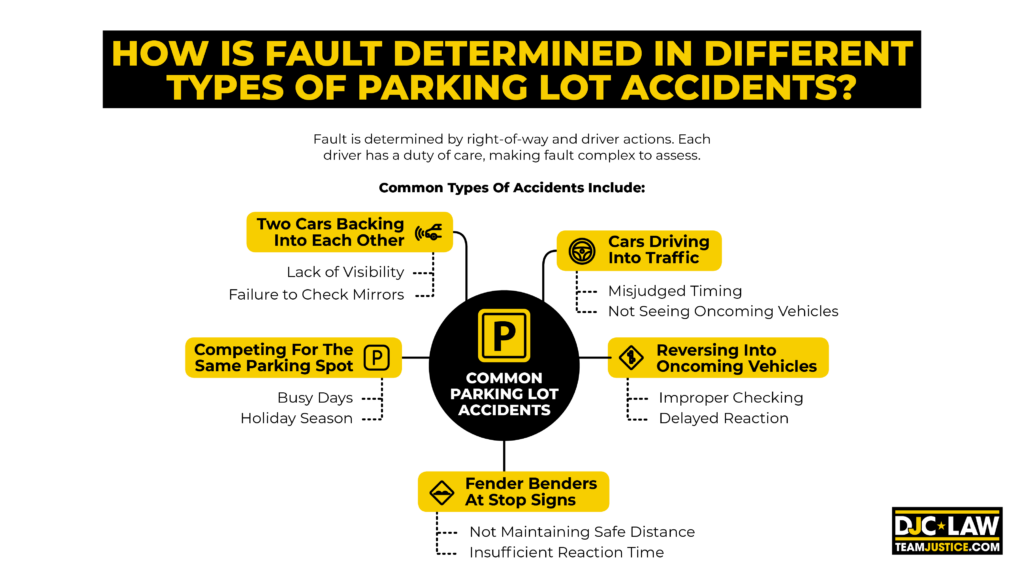
Fault is determined by examining who had the right of way and the actions each driver took. Ultimately, every driver owes a duty of care to other drivers and any pedestrians they encounter. Determining fault is difficult, making these among the most complex accidents to manage.
According to EZ Auto Spa, 60,000 Americans are injured every year as a result of parking lot accidents. It may sound surprising, considering the low speeds involved in these accidents, but parking lots are more hazardous than many believe.
The most common types of accidents include:
-
Two Cars Backing Into Each Other – Two drivers may simultaneously reverse out of their spaces and collide because of a lack of visibility or failure to check their mirrors.
-
Cars Driving Into Traffic – Exiting a parking garage and entering traffic is another common type of accident. Drivers often misjudge the timing or don’t see oncoming vehicles.
-
Reversing Into Oncoming Vehicles – Austin Accidents can occur when a car reverses out of a space and into the path of an oncoming vehicle that fails to react in time. This often happens when drivers don’t check properly for other vehicles.
-
Competing for the Same Parking Spot – Parking lots can lead to road rage flaring. Two drivers may collide if competing for the same spot, especially on busy days, such as during the holiday season.
-
Fender Benders at Stop Signs – Drivers waiting at stop signs may not maintain a safe distance, thus not giving vehicles enough time to slam on their breaks.
Since drivers share responsibility for everyone’s care, determining fault is complex. Factors like who made a left turn, how far a vehicle is into a parking space, the point of impact, and driving speeds are all considered when deciding who’s at fault.
Who Has the Right of Way in a Parking Lot in Texas?
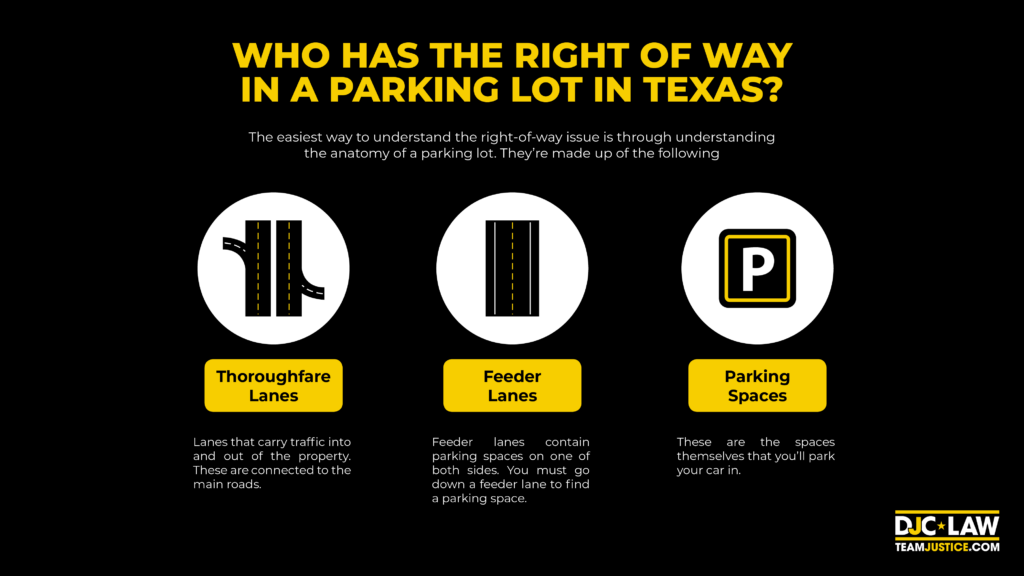
Many drivers are confused about the right of way. In Texas, the driver in the “thoroughfare lanes” has the right of way. The exception is if there’s a stop or yield sign, which gives cars the right of way to leave their spots.
Right of way contributes to vast numbers of accidents nationwide. According to the National Safety Council (NSC), failure to yield right of way results in 6.9% of fatal crashes yearly. A lack of understanding and a lack of courtesy contribute to these incidents, and nowhere is this more prominent than in a parking lot.
The easiest way to understand the right-of-way issue is through understanding the anatomy of a parking lot. They’re made up of the following:
-
Thoroughfare Lanes – Lanes that carry traffic into and out of the property. These are connected to the main roads.
-
Feeder Lanes – Feeder lanes contain parking spaces on one of both sides. You must go down a feeder lane to find a parking space.
-
Parking Spaces – These are the spaces themselves that you’ll park your car in.
The easiest way to think about these three parts of the parking lot is as follows: thoroughfare lanes, which are highways; feeder lanes, which are ordinary neighborhood streets; and parking spaces, which are driveways. Like on the main roads, traffic from smaller streets must always yield to the traffic on the faster roads.
And the same principle applies to the parking lot.
What to Do If You Are in a Parking Lot Accident?
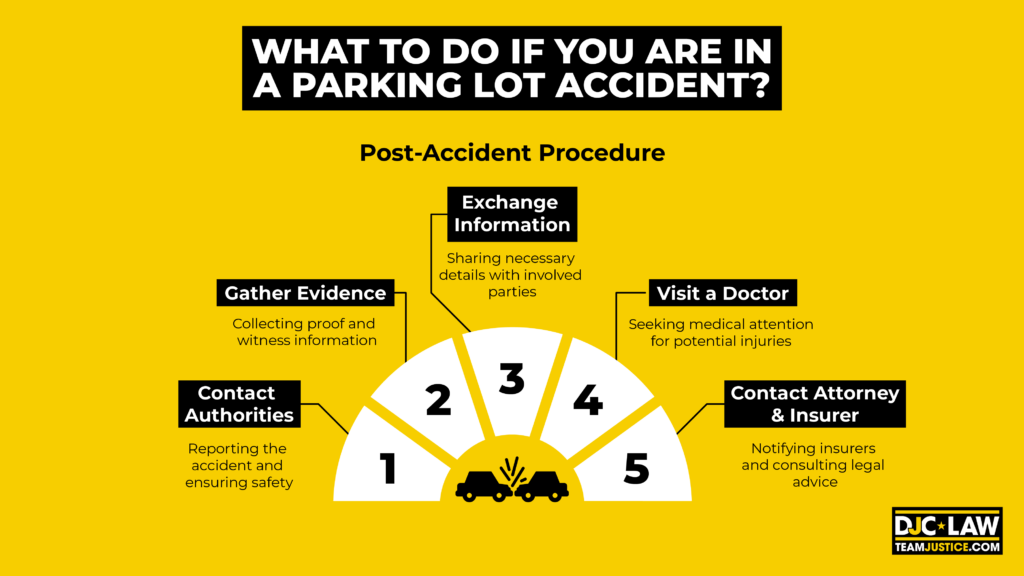
Call the authorities after a parking lot accident, gather evidence, exchange information with the other driver, seek medical attention, and call your lawyer and insurance provider. Following these steps is essential for complying with the law and supporting a later personal injury claim.
Let’s go through these steps in further detail.
Step One – Contact the Authorities
Call 911 and report the accident to the police if the property damage exceeds $1,000. FindLaw states that all accidents with $1,000 or more in property damage must be officially reported. Failure to do so could get you charged for a hit-and-run incident.
You can also ask for an ambulance if anyone is injured. Although most low-speed collisions rarely lead to serious damage, it’s essential to inspect your vehicle regardless. If you’re unsure whether your accident warrants calling the authorities, do so anyway. It’s always better to be on the safe side!
Step Two – Gather Evidence
Assuming nobody is hurt, it’s time to gather evidence of what happened. Take photos of each vehicle and any damage sustained. If you have any visible injuries, you should take photos of those as well. It’s also worth capturing some images of any nearby signage.
If there were any witnesses, ask them if they’d be willing to provide a statement. Take down their contact details for later. Note that eyewitnesses aren’t required to cooperate.
Step Three – Exchange Information
You’re legally required to exchange information with the other driver. The insurance information should mention the following:
-
Vehicle information
-
Policyholder’s name
-
Name of the insurance company
-
Contact information
-
Policy number
This information can be a paper copy or a digital copy on their phone. If the other driver refuses to provide these details, notify the police immediately.
Step Four – Visit a Doctor
Visit a doctor if you’re injured. Many injuries don’t appear for hours or days until after the initial impact because of that initial adrenaline rush after the accident. Your medical records can also provide vital evidence to support your case later.
Don’t underestimate how common delayed injuries are. According to ScienceDirect, delayed whiplash symptoms persist for more than six months after the initial injury in 40% of cases.
Step Five – Contact Your Attorney and the Insurance Company
Most auto insurance companies have reporting requirements built into all policies. Expect this to range from 24 to 72 hours to report your accident, regardless of how much or how little damage was incurred.
You’ll also need an attorney to assist with your claim. Remember, the insurer isn’t your friend and will use every trick in the book to avoid paying out your insurance claim.
What are the Common Causes of Parking Lot Accidents?
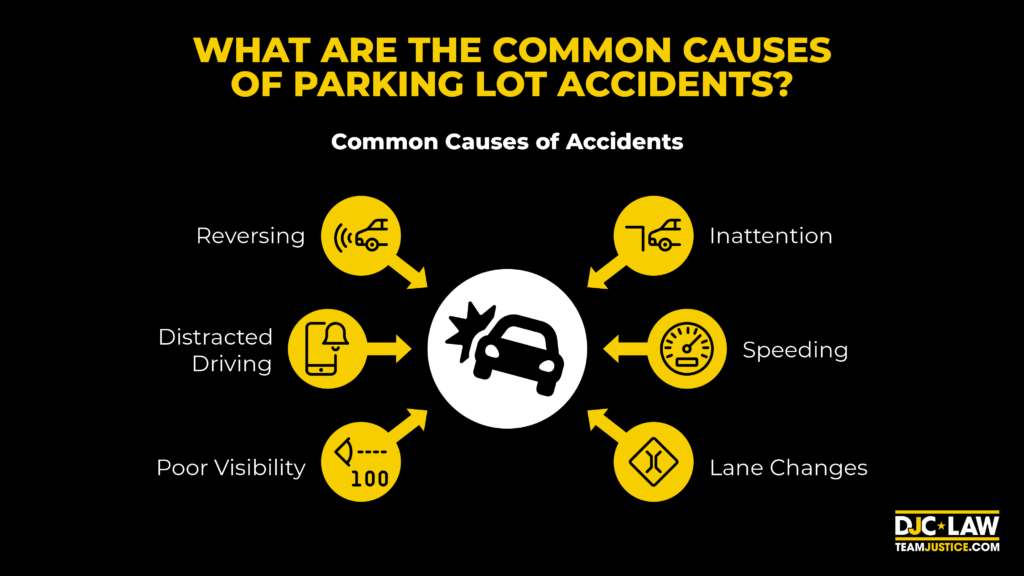
Reversing, inattention, and distracted driving are the leading causes of parking lot accidents. Many drivers let their guards down because of the low speeds involved, but car accident cases in the lot can be just as dangerous as a crash out on a highway or intersection.
Here are the most common causes of accidents:
-
Reversing – Reversing makes you vulnerable because your visibility may be hampered by other vehicles, preventing you from seeing oncoming vehicles or pedestrians coming your way.
-
Inattention – If drivers don’t pay attention to their surroundings, there’s a good chance they’ll hit something. Practice making a note of pedestrians and oncoming vehicles before driving.
-
Distracted Driving – Distracted driving means you’re trying to split your focus between driving and something else. This could be texting, talking on the phone, talking to someone else in the car, or changing the radio station. According to Forbes, nine people die daily from distracted driving.
-
Speeding – Driving too fast always increases your risk of an accident, and the parking garage is no exception. Speeding doesn’t give you or anyone else time to react, meaning you’ve got a higher chance of hitting something.
-
Poor Visibility – Crowded parking garages often make it tough to spot potential hazards coming your way. Open-air parking lots can also be tricky to navigate in rainy and snowy conditions.
-
Lane Changes – Navigating multiple rows and parking lanes also increases your risk of getting involved in an accident. Practice double-checking before turning or backing out to ensure you don’t accidentally hit someone.
What all these issues have in common is attentiveness. Smart drivers pay as much attention to what’s happening in the parking lot as they do at a busy intersection. Obey the rules of the lot, look around, and focus on the task at hand.
What Should You Do If You Are At Fault?
Being at fault for an accident in a parking lot doesn’t change your duty of care. Follow the same steps of gathering evidence and exchanging details as you would if someone had driven into you.
The same goes if you hit a parked car and the owner isn’t around. Most parking lots have surveillance, and an eyewitness may have seen you. Leaving without notifying the owner is a criminal offense, and if caught, you’ll have far bigger problems than worrying about your insurance premiums rising.
Staying around and following the rules is just the right thing to do.
How to File a Car Accident Report After a Parking Lot Accident
Filing a car accident report after a parking lot accident depends on the extent of the damage. In Texas, you must only file a report if property damage exceeds $1,000 or somebody is hurt. However, you’re always required to report any accident to your insurer.
If the police must be notified, an officer will arrive and fill out an official police accident report. This provides vital details from the scene and will be used as part of your auto accident claim later. Note that you can also file your own report online with the Texas Department of Transportation if the police choose not to attend.
It may be tempting not to call your insurance company if the damage is relatively minor because you’re afraid of your insurance premiums rising. However, it’s a false economy because the rate increase is usually less than the cost of paying for the repairs out-of-pocket.
Moreover, not reporting an accident could invalidate your coverage if it later emerges that you didn’t report it within the policy’s limits. In all cases, pick up the phone and call your insurer to report your accident as soon as possible.
How to Avoid Parking Lot Accidents
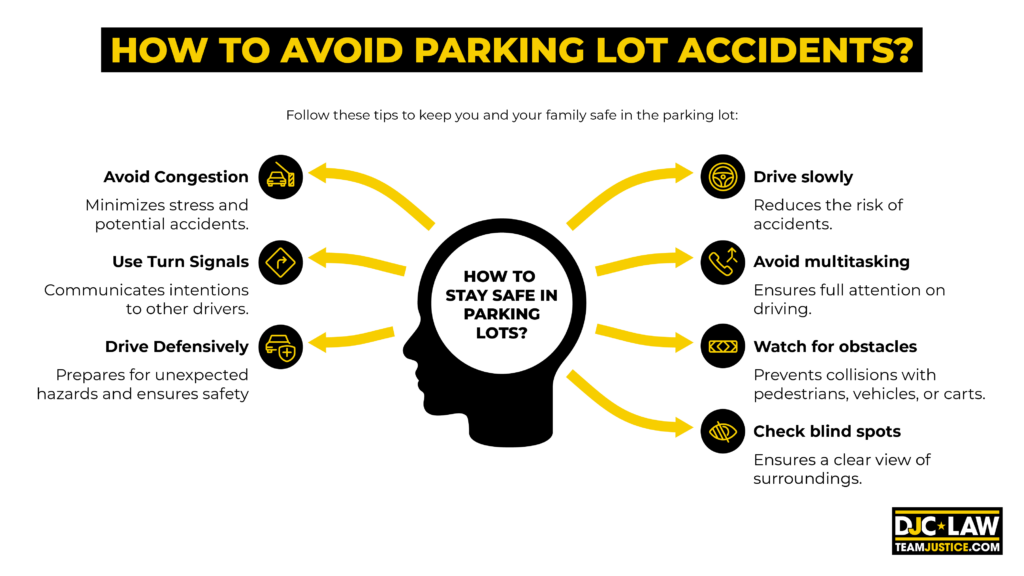
Avoiding parking lot accidents means utilizing the same care and attention as you would on any other road. Slow down, limit distractions, and take the time to look around you for sudden hazards constantly.
Follow these seven tips to keep you and your family safe in the parking lot:
-
The first rule of parking lots is to drive slowly and take it easy.
-
Don’t get tempted to multi-task. Put the phone away and focus on the road.
-
Watch out for any obstacles, whether a pedestrian, another vehicle, or a discarded cart.
-
Use your mirrors and look around physically to check your blind spots.
-
Try to avoid congested parking areas, even if it means walking a little further. Even better, if you can pull all the way through, you can avoid the risk of reversing out later.
-
Don’t make the mistake of forgetting about your turn signals in parking lots.
-
Drive defensively at all times to give yourself the best chance of reacting to hazards.
Being the best driver in the world doesn’t necessarily mean you won’t get into an accident. Other people tend to drop their guards in the parking garage because of the low speeds, but by implementing the above tips, you can reduce your chance of being involved in a collision.
Does Your Insurance Go Up If You Are in a Parking Lot Accident?
Parking lot accidents are no different from accidents anywhere else. Every time you report an accident, it will go on your driving record. If you were found to be at fault, it could impact your car insurance premiums.
The fact that parking lot accidents do impact premiums means many drivers choose not to report these accidents if there’s only minor damage. However, this is breaking the terms of your policy. If the other driver reports it or the authorities get involved, your insurer has countless ways to find out about it.
Although it’s not a crime to not report the accident to your insurer, your policy could be invalidated. If you try to get another policy later, you’ll find yourself paying far more than if you’d just reported the collision in the first place.
What is Collision Insurance?
Collision insurance is coverage that will pay for repairing your vehicle if you’re involved in an accident. All you have to pay is the out-of-pocket deductible, and the insurer will pay for the rest, regardless of who’s at fault. It’s usually optional, but if you’re leasing or financing a vehicle, you may be required to carry it.
In the context of a parking lot crash, collision insurance will pay for your vehicle’s repairs, whether the accident was your fault or the other driver’s. That’s why it’s a handy piece of coverage to have.
What if I Hit a Parked Car and Can’t Find the Vehicle Owner?
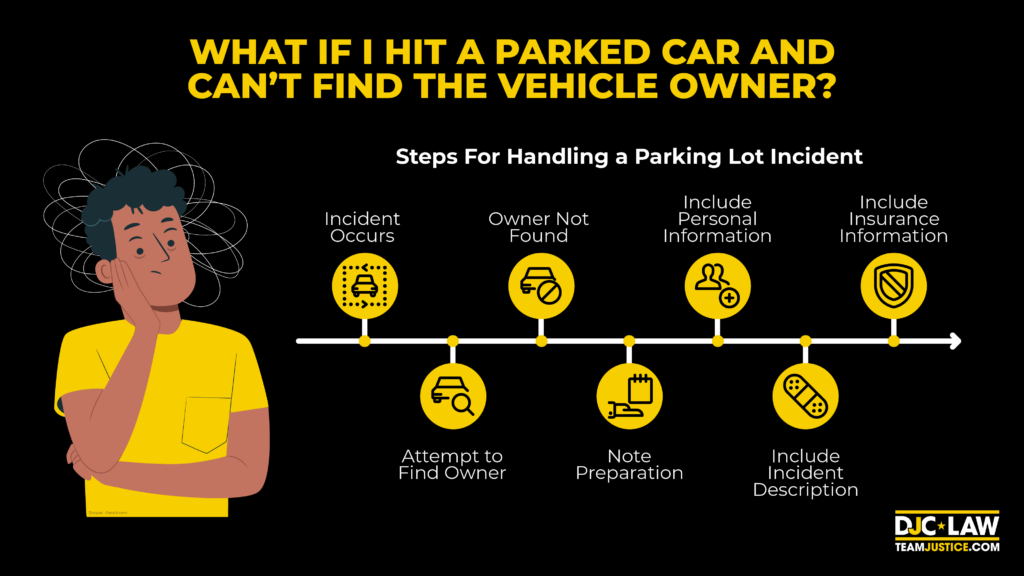
Hitting a parked car and not making a reasonable effort to notify the owner is against the law in every state. If there’s surveillance or an eyewitness spots you were leaving without providing your details, you could be charged with a criminal offense.
Most states require you to make reasonable efforts to find the owner. It could mean entering the business the parking lot is part of and trying to find the owner. However, if you can’t find them, you must make a note, which includes the following information:
-
Your name.
-
Your address.
-
Your contact number.
-
What happened.
-
Your insurance information.
Keep it short and sweet, as any information in your note could still be used as evidence against you when pursuing a claim.
What Can Pedestrians Do to Protect Themselves in a Parking Lot?
Nearly 500 people die annually in parking lots, per Transline. Parking lots are dangerous places for unprotected pedestrians, meaning you must take the necessary steps to defend yourself from oncoming vehicles.
Follow these tips for protecting yourself as a pedestrian in a parking lot:
-
Park in well-lit areas so everyone can see you.
-
Park as close to the business you’re going into as possible.
-
Follow walkways and other signage instead of trying to take shortcuts.
-
Avoid walking while distracted by your phone, headphones, or anything else in your pockets.
-
Look both ways whenever moving across thoroughfare lanes or feeder lanes.
The number one rule as a pedestrian is to treat parking lots like any other busy street. Don’t let your guard down just because you’re in the parking lot.
Why Should I Hire a Car Accident Attorney to Handle My Case?
Getting a lawyer after a minor car accident may seem unnecessary, but pursuing your claim without an attorney dramatically reduces how much compensation you’ll receive. Hiring a lawyer gives you the legal experience and expertise to dodge difficult insurance companies and avoid the stress of pursuing a claim.
Unsure whether to hire a car accident attorney to manage your case? Here’s why you should:
-
Attorneys are well-versed in the law, enabling them to protect your rights and manage the legal complexities of your personal injury claim.
-
Car accident attorneys possess the investigative skills needed to gather further evidence and put it all together as a strong case.
-
Your lawyer will negotiate with the insurance company, ensuring you get the rightful compensation you’re entitled to.
-
In the worst-case scenario, your case may end up in court. It’s your attorney’s job to guide you through the process and give you the best chance of victory.
-
It’s a proven fact that a lawyer will always net you more compensation than you could get if fighting your own case. According to Nolo, lawyers increase average compensation amounts by up to four times as much.
Tackling even a minor parking lot accident shouldn’t happen without legal expertise by your side. Get in touch with a Texas personal injury attorney for your free consultation today!


